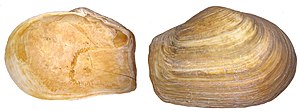Mya (genus)
| Mya | ||||||||||||
|---|---|---|---|---|---|---|---|---|---|---|---|---|

Truncated clam ( Mya truncata ) |
||||||||||||
| Systematics | ||||||||||||
|
||||||||||||
| Scientific name | ||||||||||||
| Mya | ||||||||||||
| Linnaeus , 1758 |
Mya is a clam genus of from the family of clams (Myidae). It is the type genus of this family. The oldest fossil representatives of the genus come from the Oligocene .

features
The housing is slightly unevenly hinged, the right flap is slightly larger than the left flap. The outline of the housing is mostly oblong or transversely elliptical, also rounded transversely rectangular. The front end is rounded, the rear end rounded or trimmed. There is a gap at the rear end, i.e. H. there is a wide gap even when the housing is otherwise closed. It is also more or less clearly unequal, the vertebrae sit in front of the center line (based on the length of the case). Lunula and area are not developed. The edges of the case are smooth on the inside. The lock is toothless or with a cardinal tooth in both flaps. The ligament is mostly internal, in a large and well-trained resilifer . There is a chondrophore in the left flap . The two large siphons are combined into a single tube, which is surrounded by a layer of periostracum. The surface line is deeply indented. Juvenile animals still have a byssus or a byssus gland, in older animals the gland is regressed and accordingly no more byssus is present. There are two sphincters. The posterior sphincter is usually slightly smaller than the anterior.
The shell is usually thick and not particularly tight, but it can also be very thin. The ornamentation usually consists of ridges parallel to the edge and strips of growth.
Geographical distribution and habitat
The genus Mya is restricted to the arctic and cool temperate waters of the northern hemisphere. The animals usually live deeply buried in the silty-sandy sediment of the tidal area up to a depth of about 75 meters.
Taxonomy
The taxon was established by Carl von Linné in 1758 . MolluscaBase recognizes four recent species as valid species. Other authors list six recent species. This list of species is supplemented with the fossil species listed by the Paleobiology Database and the species described by MacNneil.
- Genus Mya Linnaeus, 1758
- Sand Gap Clam ( Mya arenaria Linnaeus, 1758)
- † Mya arrosis MacNeil, 1965 (Upper Miocene)
- Mya baxteri Coan & Valentich-Scott, 1997
- † Mya convexa Noda, 1992 (Eocene) ( preoccupied by Mya convexa Wood, 1815)
- † Mya cuneiformis (Böhm, 1915) (Miocene / Pliocene)
- † Mya dickersoni Clark, 1915 (Upper Miocene)
- † Mya elegans (Eichwald, 1871) (Pliocene)
- † Mya ezoensis Nagao & Inoue, 1941 (Lower Oligocene)
- † Mya fujiei MacNeil, 1965 (Middle Miocene)
- † Mya grewingki Makiyama, 1935 (Oligocene / Miocene)
- † Mya ilyinensis Sinelnikova, 1991 (?)
- † Mya japonica Jay, 1858 (Pliocene / Pleistocene)
- † Mya kovatschensis Kristofovich, 1947 (Eocene)
- † Mya kusiroensis Nagao & Inoue, 1941 (Oligocene)
- † Mya majanatschensis Ilyina, 1963 (Oligocene)
- † Mya priapus Tilesius, 1822 (Pliocene?)
- † Mya producta Conrad, 1838 (Middle Miocene)
- Mya pseudoarenaria Schlesch, 1931 (Pliocene to recent)
- Mya pullus Sowerby, 1826 (Lower Pleistocene)
- † Mya sachalinensis Kristofovich, 1957 (Eocene)
- † Mya salmonensis Clark, 1932 (Oligocene / Miocene)
- † Mya schweinfurthi Mayer-Eymar, 1887 (Eocene)
- † Mya tigilensis Kristofovich, 1947 (Eocene)
- Truncated clam ( Mya truncata Linnaeus, 1758)
- † Mya virgo Martin, 1879 (Miocene)
- † Mya wilsoni Ward, 1992 (Oligocene / Miocene)
Type species of the genus is Mya truncata Linnaeus, 1758 by the later determination by John George Children .
supporting documents
literature
- Michael Amler, Rudolf Fischer & Nicole Rogalla: Mussels . Haeckel library, Volume 5. Enke Verlag, Stuttgart 2000, ISBN 3-13-118391-8 .
- Rudolf Kilias: Lexicon marine mussels and snails. 2nd edition, 340 p., Verlag Eugen Ulmer, Stuttgart 1997, ISBN 3-8001-7332-8 (p. 207).
- Fritz Nordsieck : The European sea shells (Bivalvia). From the Arctic Ocean to Cape Verde, the Mediterranean Sea and the Black Sea. 256 pages, Gustav Fischer Verlag, Stuttgart 1969.
- Guido Poppe and Yoshihiro Goto: European Seashells Volume 2 (Scaphopoda, Bivalvia, Cephalopoda) . 221 p., Verlag Christa Hemmen, Wiesbaden 1993 (2000 unc. Reprint), ISBN 3925919104 (p. 127/8).
Individual evidence
- ^ A b Raymond Cecil Moore (Ed.): Treatise on invertebrate paleontology. Mollusca, 6, Part N, Bivalvia 2. XXXVIII S., pp. N491-N951, New York 1969 (pp. N691 / 2).
- ^ Carl von Linné: Systema naturae per regna tria naturae, secundum classes, ordines, genera, species, cum characteribus, differentiis, synonymis, locis. Tomus I. Editio decima, reformata. Pp. 1–824, Holmia / Stockholm, Salvius, 1758, online at www.biodiversitylibrary.org (p. 670).
- ↑ Lamarck: MolluscaBase: Myidae, 1809 .
- ↑ Linnaeus: Paleobiology_Database: Mya 1758 .
- ↑ a b c d e f g h i j F. Stearns MacNeil: Evolution and Distribution of the Genus Mya, and Tertiary Migrations of Mollusca. In: United States Geological Survey Professional Paper , 483-G: G1-G51, Washington, 1965 Online at Google Books .
- ↑ a b Tsutomu Fujie: On the Myarian Pelecypods of Japan: Part I. Summary of the Study of the Genus Mya from Hokkaido. In: Journal of the Faculty of Science, Hokkaido University. Series 4, Geology and Mineralogy , Vol. 9, No. 4, 1957, pp. 381-413, URL .
